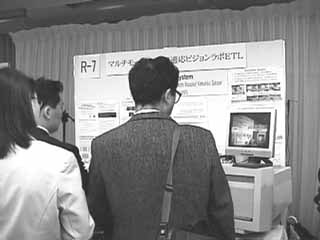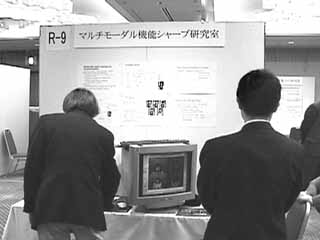| Theme and Laboratory
| Outline |
Wearable Vision System
RWI Adaptive Vision
Laboratory
http://www.etl.go.jp/~7234/

| We have developed a wearable vision system with a head-set consisting
of an ultra-small CCD camera and an ultra-small display. By wearing the
head-set, the system immediately informs the user of the results of
sophisticated real-time image processing of the image obtained in the same
viewpoint as the user.
We demonstrate overlaying and displaying of various types of notation
information in the scene (introduction of exhibited item or emergency
exit, etc.) on the image and demonstrate how 3-D information is acquired
just by looking around the hand-held object. The image processing is
executed by a PC cluster and a wireless LAN is used for data transmission
between the user and the computers. In the future, we intend to develop a
wearable assistant whereby smart interaction is enabled by continuously
following the same experience as the user. |
Dynamic Adaptive Devices and their Application
RWI Evolvable System
Laboratory
http://www.etl.go.jp/etl/divisions/~ehw/

| We demonstrate a EMG (Electromyograph) prosthetic hand controlled by
Evolvable Hardware (EHW). EHW allows hardware to reconfigure itself with
genetic algorithms in order to adapt to new environment or to obtain new
hardware functionality. Although conventional EMG hands require almost one
month before a patient masters the usage of the hand, the EHW hand
requires only a few minutes or such a rehabilitation. This hand will be
commercialized this year. The EHW chip is also shown. The chip can be used
also for the control of an autonomous mobile robot Evolver. Evolver robot
has an adaptation speed to new environment two orders of magnitude faster.
In addion to the prosthetic hand, we also show four EHW chips. The
first chip is lossless data compression chip that is scheduled to be
discussed at ISO committee in Japan. The chip attains a compression ratio
twice better than current international standard. This data compression
will be commercialized this year. The second chip is self-reconfigurable
neural network chip which is ten times faster than Pentium II (400MHz). A
PCI board wih the chip is also shown. The third chip is the first analog
EHW chip in the world. It is an intermediate frequency filter for cellular
phones. It attains high yield rate (96%), small sizing (two fifth), and
40% reduction of power consumption. This chip has a possibility of being
commercialized this year. The fourth chip is a timing adjuster chip for
very high speed clock systems in order to improve the yield rate. The
board with the chip is shown. |
Multi-Modal Agent Interface for Communication
Multi-Modal Functions
Sharp Laboratory
http://www.rwcp.or.jp/lab/mm-sharp/paperlist.html

| In Multi-Modal Functions Sharp Laboratory, we are conducting research
and development on interactive interfaces, with the goal of realizing a
new, easy-to-use human interface. To achieve this, we record images,
speech and motion data of active conversations between people, convert the
data into a database and use the results of analyses for the interface.
From the analyses performed so far, we have found that not only the
semantic content of the conversation but also non-verbal information such
as the loudness of voice and gestures play an important role in an active
conversation. Of those pieces of information during conversation, we have
particularly focused on "back channel responses" that serves to smooth a
conversation and realized its function in the interface using an original
dynamical dialogue model into the interface. In response to the
personality of the interface itself and a user's voice, the emotion of the
interface changes in time, and gives back channel responses. The
demonstration will show a computer graphics generated person conversing
with the user with nodding and various expressions. |


